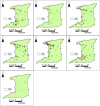Exploratory space-time analysis of dengue incidence in Trinidad: a retrospective study using travel hubs as dispersal points, 1998-2004
- PMID: 25052242
- PMCID: PMC4223768
- DOI: 10.1186/1756-3305-7-341
Exploratory space-time analysis of dengue incidence in Trinidad: a retrospective study using travel hubs as dispersal points, 1998-2004
Abstract
Background: Dengue is an acute arboviral disease responsible for most of the illness and death in tropical and subtropical regions. Over the last 25 years there has been increase epidemic activity of the disease in the Caribbean, with the co-circulation of multiple serotypes. An understanding of the space and time dynamics of dengue could provide health agencies with important clues for reducing its impact.
Methods: Dengue Haemorrhagic Fever (DHF) cases observed for the period 1998-2004 were georeferenced using Geographic Information System software. Spatial clustering was calculated for individual years and for the entire study period using the Nearest Neighbor Index. Space and time interaction between DHF cases was determined using the Knox Test while the Nearest Neighbor Hierarchical method was used to extract DHF hot spots. All space and time distances calculated were validated using the Pearson r significance test.
Results: Results shows that (1) a decrease in mean distance between DHF cases correlates with activity leading up to an outbreak, (2) a decrease in temporal distance between DHF cases leads to increased geographic spread of the disease, with an outbreak occurrence about every 2 years, and (3) a general pattern in the movement of dengue incidents from more rural to urban settings leading up to an outbreak with hotspot areas associated with transportation hubs in Trinidad.
Conclusion: Considering only the spatial dimension of the disease, results suggest that DHF cases become more concentrated leading up to an outbreak. However, with the additional consideration of time, results suggest that when an outbreak occurs incidents occur more rapidly in time leading to a parallel increase in the rate of distribution of the disease across space. The results of this study can be used by public health officers to help visualize and understand the spatial and temporal patterns of dengue, and to prepare warnings for the public. Dengue space-time patterns and hotspot detection will provide useful information to support public health officers in their efforts to control and predict dengue spread over critical hotspots allowing better allocation of resources.
Figures





References
-
- Dizon JJ, San Juan RB. Philippine haemorrhagic fever: epidemiological notes. J Philipp Med Assoc. 1966;9:566–577. - PubMed
-
- Kalra NL, Wattal Baghvan NGS. Distribution pattern of Aedes (stegomyia) aegypti in India and some ecological considerations. Bull Indian Soc Mal Commun Dis. 1968;5(307):334.
-
- Halstead SB. Dengue review of infectious diseases. Rev Infect Dis. 1984;6:275–288. - PubMed
-
- Morrison AC, Getis A, Santiago M, Rigua-Perez JG, Reiter P. Exploratory Space-Time Analysis of Reported Dengue Cases during an Outbreak in Florida, Puerto Rico, 1991–1992. Am J Trop Med Hyg. 1998;58(3):287–298. - PubMed
Publication types
MeSH terms
LinkOut - more resources
Full Text Sources
Other Literature Sources
Medical

